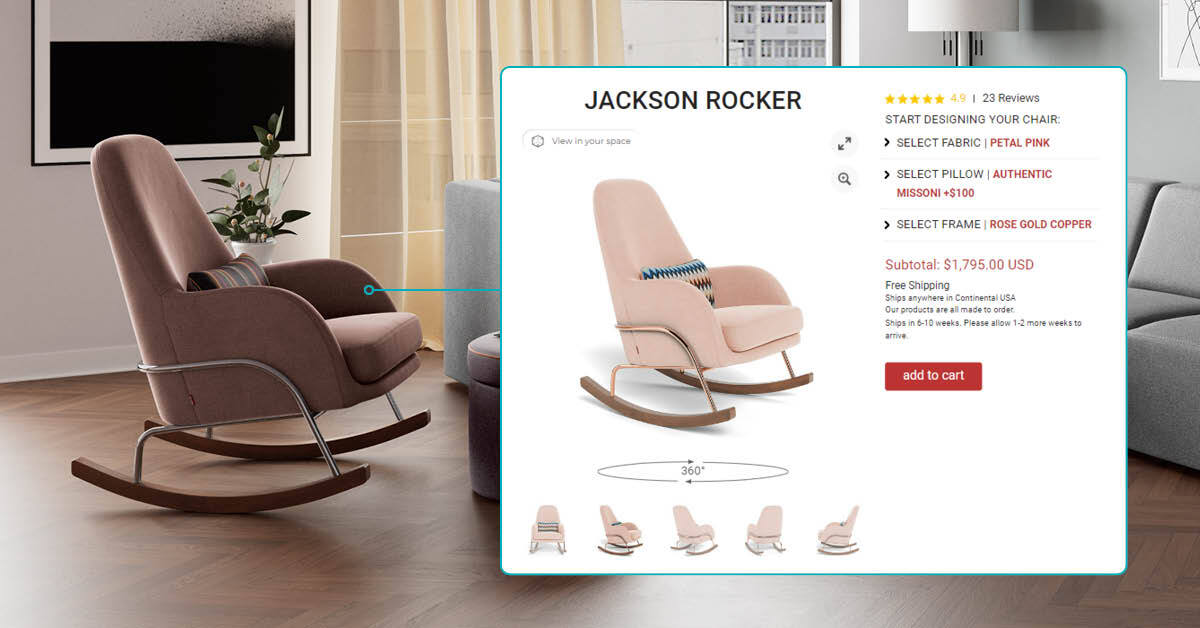A recent Forrester study, commissioned by Cylindo, delves into the heart of digital evolution, analyzing the furniture industry’s journey as it leans into groundbreaking technologies such as AR, VR, AI, and, particularly, 3D visualization.
We welcomed our guest speaker, Michelle Beeson, Senior Analyst at Forrester Consulting, to discuss the adoption of emerging technologies in the furniture industry.
Here are the 5 key takeaways:
1. The furniture industry is embracing a digital evolution
Success in furniture—or almost any line of business in a digital-first world—depends upon technology. One thing is clear from this research: The appetite for emerging technologies is high. Groundbreaking technologies are revolutionizing the furniture landscape, from how consumers shop to how the furniture industry operates. As furniture businesses continue to be challenged by tech-savvy players in the space, companies without strong digital strategies will fall behind.
2. AI tools are gaining ground in imagery creation
Businesses are hyped about the potential of artificial intelligence, and the furniture industry is certainly not immune to this trend. AI tools are becoming an integral part of product and lifestyle imagery creation, with 56% of furniture organizations employing them to automatically generate or modify images. They are also used in image recognition, classification, and tagging by 52% of organizations. Forty-two percent of furniture companies use AI for real-time customization and adaptation of imagery.
3. 3D visualization is critical to achieving key business priorities
Customers’ shopping behavior has evolved over the years, leaving businesses with no choice but to adapt to the modern furniture purchasing journey that starts online. This forced businesses to invest in high-quality product visualization to close the online-offline gap. The nature of the furniture industry makes product visualization a crucial part of the overall business strategy. Data from Forrester’s study shows that 93% of furniture leaders rated 3D product visualization services as very to extremely important for their current business strategy.
4. Failing to recognize the importance of 3D product visualization can be detrimental
Without a solid 3D product visualization strategy in place, furniture businesses can’t position themselves as leaders in the furniture space. One of the things that distinguishes leading furniture businesses is their approach to 3D product visualization. Making it the pillar of your business sets the foundation for future growth and future-proofs your business in this digital-first era.
5. Furniture visualization will become an industry standard and a key differentiator
The furniture industry is going through rapid change. Changes such as the explosion of digital, the empowered customer, and the acceleration of innovation are having a profound impact on customer expectations. This poses the question: What are the technologies that will revolutionize the customer experience? One area that holds particular promise is product visualization. According to the survey of furniture industry leaders, there is a positive outlook toward a more technologically advanced industry landscape.
Watch the webinar recording to explore the tech trends affecting the furniture industry.

Curious to find out how technology is revolutionizing the furniture industry? Get the executive summary of the Forrester study, commissioned by Cylindo, to explore the adoption of emerging technologies, the challenges along the way, and the impact on business outcomes.



